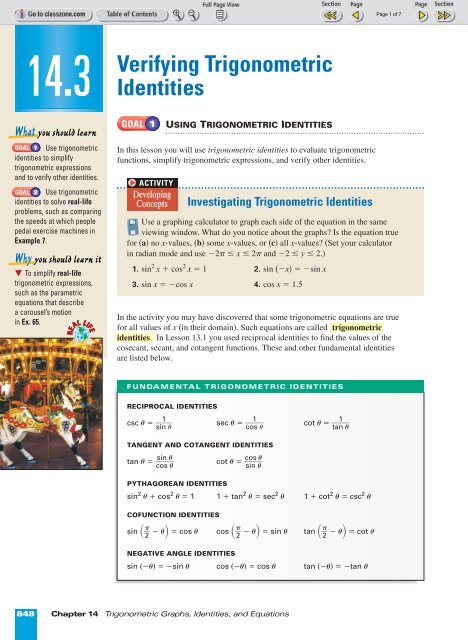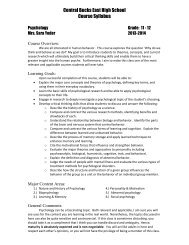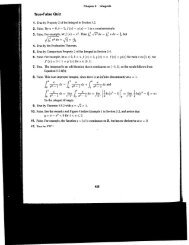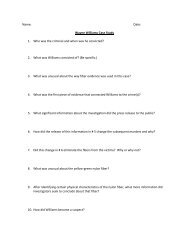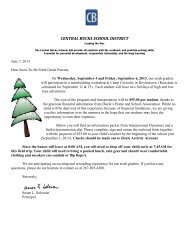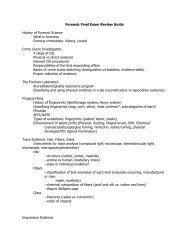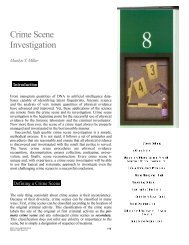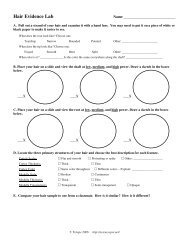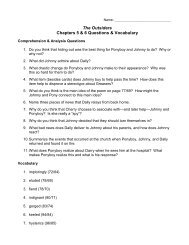14.3 - Verifying Trigonometric Identities 848-854.pdf
14.3 - Verifying Trigonometric Identities 848-854.pdf
14.3 - Verifying Trigonometric Identities 848-854.pdf
Create successful ePaper yourself
Turn your PDF publications into a flip-book with our unique Google optimized e-Paper software.
<strong>14.3</strong><br />
What you should learn<br />
GOAL 1 Use trigonometric<br />
identities to simplify<br />
trigonometric expressions<br />
and to verify other identities.<br />
GOAL 2 Use trigonometric<br />
identities to solve real-life<br />
problems, such as comparing<br />
the speeds at which people<br />
pedal exercise machines in<br />
Example 7.<br />
Why you should learn it<br />
To simplify real-life<br />
trigonometric expressions,<br />
such as the parametric<br />
equations that describe<br />
a carousel’s motion<br />
in Ex. 65.<br />
REAL<br />
REAL LIFE<br />
LIFE<br />
<strong>Verifying</strong> <strong>Trigonometric</strong><br />
<strong>Identities</strong><br />
GOAL 1<br />
USING TRIGONOMETRIC IDENTITIES<br />
In this lesson you will use trigonometric identities to evaluate trigonometric<br />
functions, simplify trigonometric expressions, and verify other identities.<br />
ACTIVITY<br />
Developing<br />
Concepts<br />
Investigating <strong>Trigonometric</strong> <strong>Identities</strong><br />
Use a graphing calculator to graph each side of the equation in the same<br />
viewing window. What do you notice about the graphs? Is the equation true<br />
for (a) no x-values, (b) some x-values, or (c) all x-values? (Set your calculator<br />
in radian mode and use º2π ≤ x ≤ 2π and º2 ≤ y ≤2.)<br />
1. sin 2 x + cos 2 x = 1 2. sin (ºx) = ºsin x<br />
3. sin x = ºcos x 4. cos x = 1.5<br />
In the activity you may have discovered that some trigonometric equations are true<br />
for all values of x (in their domain). Such equations are called trigonometric<br />
identities. In Lesson 13.1 you used reciprocal identities to find the values of the<br />
cosecant, secant, and cotangent functions. These and other fundamental identities<br />
are listed below.<br />
FUNDAMENTAL TRIGONOMETRIC IDENTITIES<br />
RECIPROCAL IDENTITIES<br />
1<br />
1<br />
csc † = sec † = <br />
sin †<br />
cos<br />
†<br />
cot † = 1<br />
<br />
tan †<br />
TANGENT AND COTANGENT IDENTITIES<br />
sin<br />
†<br />
tan † = cot † = <br />
cos<br />
†<br />
cos<br />
†<br />
<br />
sin<br />
†<br />
PYTHAGOREAN IDENTITIES<br />
sin 2 † + cos 2 † = 1 1 + tan 2 † = sec 2 † 1 + cot 2 † = csc 2 †<br />
COFUNCTION IDENTITIES<br />
sin π<br />
π<br />
π<br />
º † = cos † cos<br />
2<br />
º † = sin † tan<br />
2<br />
º † = cot †<br />
2<br />
NEGATIVE ANGLE IDENTITIES<br />
sin (º†) = ºsin † cos (º†) = cos † tan (º†) = ºtan †<br />
<strong>848</strong> Chapter 14 <strong>Trigonometric</strong> Graphs, <strong>Identities</strong>, and Equations
EXAMPLE 1<br />
Finding <strong>Trigonometric</strong> Values<br />
Given that sin † = 3<br />
and π < † < π, find the values of the other five trigonometric<br />
5 2<br />
functions of †.<br />
SOLUTION<br />
Begin by finding cos †.<br />
sin2 † + cos2 † = 1 Write Pythagorean identity.<br />
3 2 + cos<br />
5 2 † = 1 Substitute } 3<br />
cos<br />
} for sin †.<br />
5 2 † = 1 º 3 2 5<br />
Subtract } 3<br />
5 }2 from each side.<br />
cos2 † = 16<br />
<br />
25<br />
Simplify.<br />
cos † = ± 4<br />
Take square roots of each side.<br />
5<br />
cos † = º 4<br />
Because † is in Quadrant II, cos † is negative.<br />
5<br />
Now, knowing sin † and cos †, you can find the values of the other four trigonometric<br />
functions.<br />
sin<br />
†<br />
tan † = = = º<br />
cos<br />
†<br />
3<br />
º<br />
os<br />
†<br />
4<br />
cot † = c = = º 4 sin<br />
†<br />
3<br />
4<br />
5 <br />
<br />
3<br />
<br />
5 <br />
3<br />
5 <br />
<br />
º 4<br />
5 <br />
1<br />
csc † = = = <br />
sin †<br />
5<br />
3 sec † = 1<br />
cos<br />
† = = º 1 5<br />
<br />
<br />
4<br />
º 4<br />
5 <br />
111<br />
<br />
3<br />
5 <br />
EXAMPLE 2<br />
Simplifying a <strong>Trigonometric</strong> Expression<br />
Simplify the expression sec † tan 2 † + sec †.<br />
SOLUTION<br />
sec † tan 2 † + sec † = sec † (sec 2 † º 1) + sec † Pythagorean identity<br />
EXAMPLE 3<br />
= sec 3 † º sec † + sec † Distributive property<br />
= sec 3 † Simplify.<br />
Simplifying a <strong>Trigonometric</strong> Expression<br />
Simplify the expression cos π<br />
2 º x cot x.<br />
SOLUTION<br />
cos π<br />
2 º x cot x = sin x cot x<br />
= sin x <br />
Cofunction identity<br />
cos<br />
x sin<br />
x<br />
Cotangent identity<br />
= cos x Simplify.<br />
<strong>14.3</strong> <strong>Verifying</strong> <strong>Trigonometric</strong> <strong>Identities</strong> 849
STUDENT HELP<br />
Study Tip<br />
<strong>Verifying</strong> an identity is<br />
not the same as solving<br />
an equation. When<br />
verifying an identity you<br />
should not use any<br />
properties of equality,<br />
such as adding the same<br />
number or expression to<br />
both sides.<br />
STUDENT HELP<br />
Study Tip<br />
In Example 6, notice<br />
how multiplying by an<br />
expression equal to 1<br />
allows you to write an<br />
expression in an<br />
equivalent form.<br />
You can use the fundamental identities on page <strong>848</strong> to verify new trigonometric<br />
identities. A verification of an identity is a chain of equivalent expressions showing<br />
that one side of the identity is equal to the other side. When verifying an identity,<br />
begin with the expression from one side and manipulate it algebraically until it is<br />
identical to the other side.<br />
EXAMPLE 4<br />
<strong>Verifying</strong> a <strong>Trigonometric</strong> Identity<br />
Verify the identity cot (º†) = ºcot †.<br />
SOLUTION<br />
cot (º†)= cos<br />
( º † )<br />
Cotangent identity<br />
sin<br />
( º † )<br />
EXAMPLE 5<br />
cos<br />
†<br />
= Negative angle identities<br />
º sin<br />
†<br />
= ºcot † Cotangent identity<br />
<strong>Verifying</strong> a <strong>Trigonometric</strong> Identity<br />
Verify the identity cot<br />
x<br />
= csc x º sin x.<br />
csc<br />
x<br />
SOLUTION<br />
cot 2 x<br />
csc x<br />
EXAMPLE 6<br />
850 Chapter 14 <strong>Trigonometric</strong> Graphs, <strong>Identities</strong>, and Equations<br />
2<br />
csc<br />
= Pythagorean identity<br />
2 x º1<br />
<br />
csc x<br />
2<br />
= csc<br />
x 1<br />
º Write as separate fractions.<br />
csc<br />
x csc<br />
x<br />
1<br />
= csc x º Simplify.<br />
csc x<br />
= csc x º sin x Reciprocal identity<br />
<strong>Verifying</strong> a <strong>Trigonometric</strong> Identity<br />
sin x<br />
Verify the identity = <br />
1º cos<br />
x<br />
1+ cos<br />
x<br />
.<br />
sin x<br />
SOLUTION<br />
sin x sin x (1 + cos x)<br />
1 + cos x<br />
= Multiply by }} .<br />
1º cos<br />
x (1 º cos x)(1 + cos x)<br />
1 + cos x<br />
sin x (1 + cos x)<br />
= <br />
Simplify denominator.<br />
2<br />
1 º cos x<br />
sin x (1 + cos x)<br />
= <br />
Pythagorean identity<br />
2<br />
sin x<br />
= 1+ cos<br />
x<br />
Simplify.<br />
sin x
STUDENT HELP<br />
HOMEWORK HELP<br />
Visit our Web site<br />
www.mcdougallittell.com<br />
for extra examples.<br />
INTERNET<br />
FOCUS ON<br />
APPLICATIONS<br />
ELLIPTICAL<br />
TRAINERS provide<br />
excellent aerobic exercise<br />
by combining both lower and<br />
upper body movements. The<br />
smooth elliptical motion<br />
produces less impact than<br />
experienced on a treadmill.<br />
REAL<br />
REAL LIFE<br />
LIFE<br />
GOAL 2<br />
USING TRIGONOMETRIC IDENTITIES IN REAL LIFE<br />
In Lesson 13.7 you learned that parametric equations can be used to describe linear<br />
and parabolic motion. They can be used to describe other types of motion as well.<br />
EXAMPLE 7<br />
Using Parametric Equations in Real Life<br />
PHYSICAL FITNESS You and Sara are riding exercise machines that involve pedaling.<br />
The following parametric equations describe the motion of your feet and Sara’s feet:<br />
YOU: SARA:<br />
x = 8 cos 4πt x = 10 cos 2πt<br />
y = 8 sin 4πt y = 6 sin 2πt<br />
In each case, x and y are measured in inches and t is measured in seconds.<br />
a. Describe the paths followed by your feet and Sara’s feet.<br />
b. Who is pedaling faster (in revolutions per second)?<br />
SOLUTION<br />
a. Use the Pythagorean identity sin 2 † + cos 2 † = 1 to eliminate the parameter t.<br />
YOU: SARA:<br />
x<br />
8 = cos 4πt x<br />
= cos 2πt Isolate the cosine.<br />
10<br />
y y<br />
= sin 4πt 6 = sin 2πt Isolate the sine.<br />
8<br />
cos2 4πt + sin2 4πt = 1 cos2 2πt + sin2 2πt = 1 Pythagorean identity<br />
x 2 y +<br />
8<br />
8<br />
2<br />
= 1<br />
x 2 y<br />
+<br />
10<br />
6<br />
2<br />
= 1 Substitute.<br />
x2 + y2 2 2<br />
x y<br />
= 64 + = 1 Simplify.<br />
100<br />
36<br />
Your feet follow a circle with a radius of 8 inches. Sara’s feet follow an ellipse<br />
whose major axis is 20 inches long and whose minor axis is 12 inches long.<br />
b. The number of revolutions per second for you<br />
and Sara is the reciprocal of the common period<br />
of the corresponding parametric functions.<br />
YOU: SARA:<br />
= = 2 = 1<br />
111<br />
<br />
= 1<br />
<br />
1<br />
In one second, your feet travel around 2 times and Sara’s feet travel around<br />
1 time. So, you are pedaling faster.<br />
2π<br />
2π<br />
<br />
111<br />
<br />
1<br />
2 <br />
111<br />
<br />
2π<br />
<br />
4π<br />
<br />
✓CHECK To check your results, set a graphing calculator to parametric, radian, and<br />
simultaneous modes. Enter both sets of parametric equations with 0 ≤ t ≤ 1 and a<br />
t-step of 0.01. As the paths are graphed, you can see that your path is traced faster.<br />
<strong>14.3</strong> <strong>Verifying</strong> <strong>Trigonometric</strong> <strong>Identities</strong> 851
GUIDED PRACTICE<br />
Vocabulary Check ✓<br />
Concept Check ✓<br />
Skill Check ✓<br />
1. What is a trigonometric identity?<br />
PRACTICE AND APPLICATIONS<br />
STUDENT HELP<br />
Extra Practice<br />
to help you master<br />
skills is on p. 959.<br />
2. Is sec (º†) equal to sec † or ºsec †? How do you know?<br />
3. Verify the identity 1 º sin 2 x cot 2 x = sin 2 x. Is there more than one way to<br />
verify the identity? If so, tell which way you think is easier and why.<br />
4. ERROR ANALYSIS Describe what is wrong with the simplification shown.<br />
cos x º cos x sin 2 x = cos x º cos x (1 + cos 2 x)<br />
= cos x º cos x º cos 3 x<br />
=ºcos 3 x<br />
Find the values of the other five trigonometric functions of †.<br />
5. cos † = º 3<br />
, π < † < π 6. tan † = 2 , 0 < † < π<br />
5 2 3 2 <br />
7. sec † = 4 π 1<br />
π<br />
, 3 < † < 2π 8. sin † = º, π < † < 3 <br />
3 2<br />
2 2<br />
Simplify the expression.<br />
9. 10. sin π<br />
2 º x sec x 11. cos2 π<br />
2 º x + cos2 (sec x + 1)(sec x º1)<br />
<br />
tan x<br />
Verify the identity.<br />
(ºx)<br />
1<br />
12. = ºcsc x<br />
sin ( ºx)<br />
13. cot x tan (ºx) = º1 14. csc x tan x = sec x<br />
15. PHYSICAL FITNESS Look back at Example 7 on page 851. Suppose your<br />
friend Pete starts riding another machine that involves pedaling. The motion of<br />
his feet is described by the equations x = 10 cos 5π<br />
5π<br />
t and y = 6 sin t. What<br />
2<br />
2<br />
type of path are his feet following?<br />
FINDING VALUES Find the values of the other five trigonometric functions of †.<br />
16. cos † = , 0 < † < π<br />
<br />
2<br />
17. tan † = 3 , 0 < † < π<br />
8 2 <br />
18. sin † = 5<br />
1<br />
<br />
5<br />
, 0 < † < π <br />
6 2<br />
19. sin † = 3 , π < † < π<br />
5 2<br />
20. cot † = º 9 π 11<br />
, 3 < † < 2π 21. cos † = º, <br />
4 2<br />
12<br />
π<br />
< † < π<br />
2<br />
22. csc † = 7<br />
0 3π<br />
, 0 < † < π 23. sec † = º1 , π < † < 5 2 3<br />
2<br />
24. tan † = º 1<br />
π<br />
, π < † < π 25. sec † = 2, 3 < † < 2π<br />
6 2 2<br />
26. csc † = º 5<br />
π 3π<br />
, π < † < 3 27. cot † = º3, < † < 2π<br />
3 2<br />
2<br />
852 Chapter 14 <strong>Trigonometric</strong> Graphs, <strong>Identities</strong>, and Equations
STUDENT HELP<br />
HOMEWORK HELP<br />
Example 1: Exs. 16–27<br />
Examples 2, 3: Exs. 28–43<br />
Examples 4–6: Exs. 44–53<br />
Example 7: Exs. 61–64<br />
SIMPLIFYING EXPRESSIONS Simplify the expression.<br />
28. cot x sec x 29. 30. sec x cos (ºx) º sin2 31. sin x (1 + cot<br />
x<br />
2 x) 32. 1 º sin2 π<br />
2 º x<br />
tan<br />
33.<br />
π<br />
cos (ºx)<br />
<br />
sin (ºx)<br />
º x 2<br />
<br />
csc x<br />
34. cos π<br />
2 º x csc x 35. + cos2 cos<br />
(ºx) 36.<br />
2 x tan 2 sin (ºx)<br />
(ºx) º 1<br />
<br />
csc x<br />
2<br />
cos x<br />
37. sec2 x º tan2 x 38. 39.<br />
40.<br />
sec x sin x + cos<br />
41.<br />
π<br />
cot x cos x<br />
<br />
tan (ºx) sin <br />
º x 2<br />
<br />
1 + sec x<br />
π<br />
2 cos<br />
º x<br />
π<br />
tan º x º1<br />
2<br />
<br />
1 + sin (ºx)<br />
π<br />
º x sec x<br />
2<br />
2<br />
1 º csc x<br />
42. cot 2 x + sin 2 x + cos 2 (ºx) 43. tan π<br />
2 º x cot x º csc 2 x<br />
VERIFYING IDENTITIES Verify the identity.<br />
44. cos x sec x = 1 45. tan x csc x cos x = 1<br />
46. cos π<br />
2 º x cot x = cos x 47. 2 º sec2 x = 1 º tan2 x<br />
48. sin x + cos x cot x = csc x 49. = cos2 cos<br />
x<br />
2 x + sin 2 x<br />
<br />
2<br />
1 + tan x<br />
50. sin<br />
2<br />
( º x)<br />
= cos 2<br />
tan<br />
x<br />
2 sin<br />
x 51. = º1<br />
π<br />
º x º 1<br />
2<br />
<br />
1 º cos (ºx)<br />
52. 1+ sin<br />
x cos x<br />
cos (ºx)<br />
+ = 2 sec x 53. = sec x + tan x<br />
cos x 1+ sin<br />
x<br />
1 + sin (ºx)<br />
IDENTIFYING CONICS Use a graphing calculator set in parametric mode to<br />
graph the parametric equations. Use a trigonometric identity to determine<br />
whether the graph is a circle, an ellipse, or a hyperbola. (Use a square viewing<br />
window.)<br />
54. x = 6 cos t, y = 6 sin t 55. x = 5 sec t, y = tan t<br />
56. x = 2 cos t, y = 3 sin t 57. x = 8 cos πt, y = 8 sin πt<br />
t t<br />
58. x = 2 cot 2t, y =3csc2t 59. x = cos , y = 4 sin 2 <br />
2<br />
60. CRITICAL THINKING A function ƒ is odd if ƒ(ºx)=ºƒ(x). A function ƒ is<br />
even if ƒ(ºx)=ƒ(x). Which of the six trigonometric functions are odd? Which<br />
of them are even?<br />
61. SHADOW OF A SUNDIAL The length s of a shadow cast by a vertical<br />
gnomon (column or shaft on a sundial) of height h when the angle of the sun<br />
above the horizon is † can be modeled by this equation:<br />
h sin ( 90°º†)<br />
s = sin<br />
†<br />
This equation was developed by Abu Abdullah al-Battani (circa A.D. 920).<br />
Show that the equation is equivalent to s = h cot †. Source: <strong>Trigonometric</strong> Delights<br />
<strong>14.3</strong> <strong>Verifying</strong> <strong>Trigonometric</strong> <strong>Identities</strong> 853
Test<br />
Preparation<br />
2<br />
★ Challenge<br />
MIXED REVIEW<br />
GLEASTON WATER MILL In Exercises 62–64, use the<br />
following information.<br />
Suppose you have constructed a working scale model of<br />
the water wheel at the Gleaston Water Mill. The parametric<br />
equations that describe the motion of one of the paddles on<br />
each of the water wheels are as follows.<br />
Actual waterwheel: Scale model:<br />
x = 9 cos 8πt x = 0.5 cos 15πt<br />
y = 9 sin 8πt y = 0.5 sin 15πt<br />
In each case, x and y are measured in feet and t is measured in minutes.<br />
62. Use a graphing calculator to graph both sets of parametric equations.<br />
63. How is your scale model different from the actual waterwheel?<br />
64. How many revolutions does each wheel make in 5 minutes?<br />
65. MULTI-STEP PROBLEM The Dentzel Carousel in Glen Echo Park near<br />
Washington, D.C., is one of about 135 functioning antique carousels in the<br />
United States. The platform of the carousel is about 48 feet in diameter and<br />
makes about 5 revolutions per minute. Source: National Park Service<br />
a. Find parametric equations that describe the ride’s motion.<br />
b. Suppose the platform of the carousel had a diameter of 38 feet and made<br />
about 4.5 revolutions per minute. Find parametric equations that would<br />
describe the ride’s motion.<br />
c. Writing How are the parametric equations affected when the speed is<br />
changed? How are the equations affected when the diameter is changed?<br />
66. Use the definitions of sine and cosine from Lesson 13.3 to derive the<br />
Pythagorean identity sin 2 † + cos 2 † = 1.<br />
67. Use the Pythagorean identity sin 2 † + cos 2 † = 1 to derive the other Pythagorean<br />
identities, 1 + tan 2 † = sec 2 † and 1 + cot 2 † = csc 2 †.<br />
QUADRATIC EQUATIONS Solve the equation by factoring. (Review 5.2 for 14.4)<br />
68. x2 º 5x º 14 = 0 69. x2 + 5x º 36 = 0 70. x2 º 19x + 88 = 0<br />
71. 2x 2 º 7x º 15 = 0 72. 36x 2 º 16 = 0 73. 9x 2 º 1 = 0<br />
EVALUATING EXPRESSIONS Evaluate the expression without using a<br />
calculator. Give your answer in both radians and degrees. (Review 13.4 for 14.4)<br />
74. cos º1<br />
75. tan º1 3 76. sin º1º <br />
77. sin º1 1<br />
2 78. tanº1 (º1) 79. cos º1º<br />
1<br />
2 <br />
2<br />
3<br />
<br />
2<br />
2<br />
GRAPHING Draw one cycle of the function’s graph. (Review 14.1)<br />
80. y = 4 sin x 81. y = 2 cos x 82. y = tan 4πx<br />
83. y = 3tan πx 84. y = 5 cos 2x 85. y = 10 sin 4x<br />
854 Chapter 14 <strong>Trigonometric</strong> Graphs, <strong>Identities</strong>, and Equations


